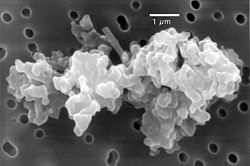Debu kosmik
Debu kosmik, juga disebut debu ekstraterestrial atau debu antariksa, adalah debu yang terdapat di luar angkasa, atau yang jatuh ke Bumi.[1][2] Sebagian besar debu kosmik berukuran antara beberapa molekul dan 0,1 µm. Debu kosmik dapat dibedakan dari lokasi astronomisnya: debu antargalaksi, debu antarbintang, debu antarplanet (seperti awan zodiak), dan cakram debu yang mengitari planet (seperti cincin planet).

Di dalam Tata Surya, debu antarplanet dapat menyebabkan cahaya zodiak. Debu Tata Surya meliputi debu komet, debu asteroid, debu dari sabuk Kuiper, dan debu antarbintang yang melintasi Tata Surya. Ribuan ton debu kosmik diperkirakan jatuh ke permukaan Bumi setiap tahunnya,[3] dan sebagian besar butiran-butiran debu tersebut memiliki massa antara 10−16 kg (0,1 pg) dan 10−4 kg (100 mg).[3] Massa jenis awan debu yang dilintasi Bumi adalah 10−6 butir debu/m3.[4]
Debu kosmik mengandung beberapa senyawa organik kompleks (yaitu padatan organik amorf dengan struktur campuran aromatik dan alifatik) yang dapat dihasilkan secara alami dan cepat oleh bintang.[5][6][7] Sebagian kecil debu di ruang angkasa adalah "debu bintang" yang terdiri dari mineral refraktori besar yang terkondensasi menjadi materi yang ditinggalkan oleh bintang.
Partikel debu antarbintang dikumpulkan oleh wahana antariksa Stardust dan sampel debu tersebut dikembalikan ke Bumi pada tahun 2006.[8][9][10][11]
Lihat pula
suntingReferensi
sunting- ^ Broad, William J. (10 Maret 2017). "Flecks of Extraterrestrial Dust, All Over the Roof". The New York Times. Diakses tanggal 10 Maret 2017.
- ^ Gengel, M.J.; Larsen, J.; Van Ginneken, M.; Suttle, M.D. (1 Desember 2016). "An urban collection of modern-day large micrometeorites: Evidence for variations in the extraterrestrial dust flux through the Quaternary". Geology. 45 (2): 119. Bibcode:2017Geo....45..119G. doi:10.1130/G38352.1 .
- ^ a b Spacecraft Measurements of the Cosmic Dust Flux", Herbert A. Zook. doi:10.1007/978-1-4419-8694-8_5
- ^ "Applications of the Electrodynamic Tether to Interstellar Travel" Gregory L. Matloff, Less Johnson, Februari, 2005
- ^ Chow, Denise (26 Oktober 2011). "Discovery: Cosmic Dust Contains Organic Matter from Stars". Space.com. Diakses tanggal 26 Oktober 2011.
- ^ Staf ScienceDaily (26 Oktober 2011). "Astronomers Discover Complex Organic Matter Exists Throughout the Universe". ScienceDaily. Diakses tanggal 27 Oktober 2011.
- ^ Kwok, Sun; Zhang, Yong (26 Oktober 2011). "Mixed aromatic–aliphatic organic nanoparticles as carriers of unidentified infrared emission features". Nature. 479 (7371): 80–3. Bibcode:2011Natur.479...80K. doi:10.1038/nature10542. PMID 22031328.
- ^ Agle, DC; Brown, Dwayne; Jeffs, William (14 Agustus 2014). "Stardust Discovers Potential Interstellar Space Particles". NASA. Diakses tanggal 14 Agustus 2014.
- ^ Dunn, Marcia (14 Agustus 2014). "Specks returned from space may be alien visitors". AP News. Diarsipkan dari versi asli tanggal 19 Agustus 2014. Diakses tanggal 14 Agustus 2014.
- ^ Hand, Eric (14 Agustus 2014). "Seven grains of interstellar dust reveal their secrets". Science News. Diakses tanggal 14 Agustus 2014.
- ^ Westphal, Andrew J.; et al. (15 Agustus 2014). "Evidence for interstellar origin of seven dust particles collected by the Stardust spacecraft". Science. 345 (6198): 786–791. Bibcode:2014Sci...345..786W. doi:10.1126/science.1252496. hdl:2381/32470 . PMID 25124433.
Pranala luar
sunting- Cosmic Dust Group
- Evidence for interstellar origin of seven dust particles collected by the Stardust spacecraft